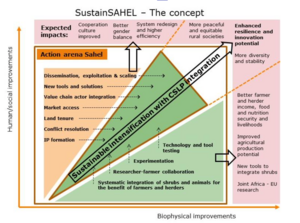Sustain Sahel Background
In the West African Sahel land degradation and soil erosion severely affect more than 80% of range- and farmlands. In addition to social, economic, political and cultural drivers—such as insecure land/tree tenure—land is degraded by ecological, agronomic, and biological factors such as heavy soil weathering, short rainy seasons, low and erratic rainfall, low biomass productivity and overgrazing.
Dryland regions, such as the Sahel, provide food for millions of poor people. One of the main limiting biophysical factors to enhance agricultural productivity in West Africa is the low precipitation use efficiency caused by poor soil quality. Water losses from runoff, evaporation, among others, can largely be prevented through water conservation and harvesting techniques including shrub integration and reduced tillage. Systematic integration of crops, shrubs, livestock and people, as well as practices of organic and conservation agriculture, are the most promising redesign typologies and interventions for sustainable intensification. SustainSahel adopts a demand-driven, scale-appropriate, participatory approach to investigate these systems.
Project approach
Sustain Sahel believes that transformational change must include strengthening of farmer organisations linked with consumers through restructured value chains, digitally enabled information services (market, production and weather forecast), climate-resilient practices, as well as, more investments.
The concept is based on the systematic integration of crops, shrubs, livestock (CSL), and with the involved people (P:farmers, herders, other practitioners) on an intensification process engaging both natural and social researchers (CSLP). The intensification shall improve both biophysical and human/social conditions, as seen in the figure. The action arena, the space where the project is active, is concentrated on specific territories where CSLP is already existing sporadically. This existing structures and processes shall now be systematically developed, starting with the systematic integration of shrubs and animals for the benefit of farmers and herders as well with the formation of Innovation platforms (IP) gathering the relevant stakeholders in each action arena and creating so a living lab. The 5-year intervention will launch a process, based on existing farmer, market and research structures, and contribute to at least 10 specific impacts all contributing to the SDGs.

 tap and then scroll down to the Add to Home Screen command.
tap and then scroll down to the Add to Home Screen command.